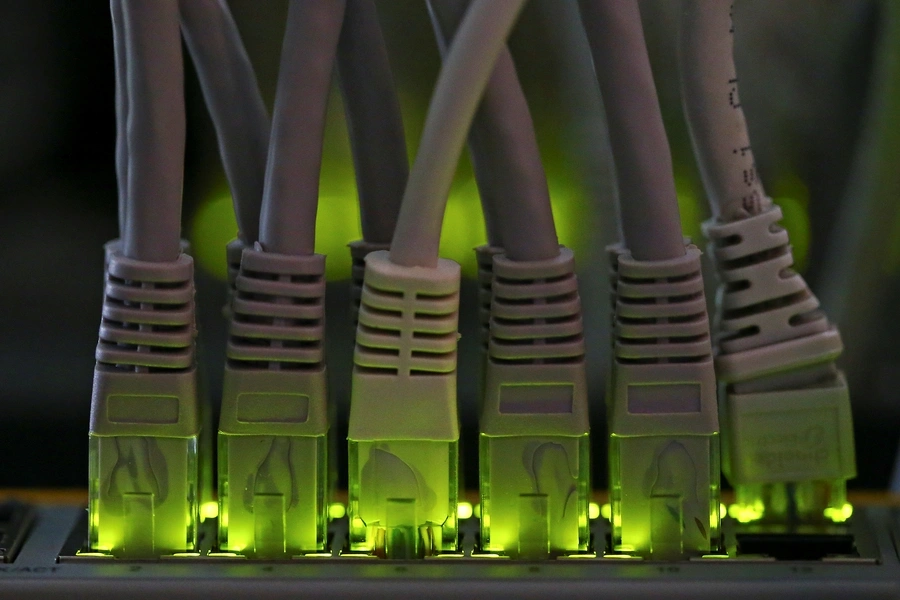This Year's Blockchain Craze Mirrors the Early Days of the Internet

Iris Zhao is an intern with the Digital and Cyberspace Policy Program at the Council on Foreign Relations.
The last year has been a rocky one for bitcoin. After skyrocketing to a valuation of $20,000 per coin at the end of 2017, prices declined precipitously throughout 2018, tanking to a yearly low of $3,210 on December 7. With its rollercoaster ups and downs and high-profile security breaches, the story of blockchain brings to mind that of the original “Wild West” of the tech industry— the internet. Both were new inventions, built upon decades of computational innovations that rapidly gained attention in technological circles. Both were hailed as revolutionary, embraced by early adopters, investors, and corporations that came to see the broad range of applications for the underlying technology. Both were seen as liberating forces freeing users from the constraints of laws and the market. And like the internet, governments will try, with moderate success, to regulate blockchain. While regulation may seem anathema to the libertarian ideas that drove blockchain’s development, it may in fact benefit the industry by granting it legitimacy.
More on:
From its inception, many envisioned the internet as a borderless world free from the influence of centralized authority, epitomized by John Perry Barlow’s “A Declaration of the Independence of Cyberspace.” The independence of cyberspace from the laws of men never came to pass. Governments enforced existing laws, ranging from copyright to child exploitation, and drafted new ones to regulate individual and corporate behavior online.
With its ability to eliminate the need for centralized authority and facilitate truly peer-to-peer transactions, blockchain became the natural successor to the internet for these libertarian hopes. This familiar belief in blockchain as free from the fiats of government, reliant upon the certainty of code alone, was evident from its initial conception in the wake of the 2008 global financial crisis. In a forum post announcing the creation of bitcoin, inventor Satoshi Nakamoto wrote that “The root problem with conventional currency is all the trust that's required to make it work. The central bank must be trusted not to debase the currency, but the history of fiat currencies is full of breaches of that trust.” The solution, was blockchain.
In creating a digital governance mechanism outside of the legal framework that ensures trust between digital partners, blockchain seems headed for the same struggle as the one that doomed Barlow’s vision of the Internet. Yet while governments will inevitably use policy to regulate blockchain, the industry could in fact stand to benefit from increased alignment with law that, if formulated correctly, would not only protect consumers but also facilitate innovation.
In order to gain widespread acceptance as an industry, blockchain applications need to develop a reputation for protecting the public—from fraud, market manipulation by bots, money laundering in cryptocurrency exchanges, and hackers’ exploitation of code vulnerabilities in smart contracts. For their part, representatives of blockchain companies involved with initial coin offerings (ICOs) expressed in a roundtable with Rep. Warren Davidson that the lack of regulatory clarity on cryptocurrency classifications and compliance issues hampered their ability to take decisive action when launching new startups. Regulatory uncertainty may also negatively impact user behavior and cryptocurrency price volatility, with blockchain advocate Aviya Arika arguing in a Cointelegraph interview that “When an investor/user is not sure about how they are going to be taxed when they sell their crypto, or about the mere legitimacy of their use of crypto, they will most likely steer clear of it altogether or just hold until further notice. These behaviors lead to a bearish market.”
Government regulation can be helped through technological innovation. There have already been promising signs that artificial intelligence can be used to detect pump and dump market manipulation schemes by analyzing the social sentiment behind bitcoin’s price fluctuations. Additionally, while much has been written about the concern that cryptocurrencies could facilitate the funding of illegal activities such as terrorism, money laundering, and drug trafficking, two of their attributes can in fact empower the government to discover such law violations. Because many blockchains are public, distributed ledgers, and the identities of those involved with bitcoin transactions are pseudonymous rather than anonymous, blockchain can be used by law enforcement to trace and prosecute cybercrime.
More on:
Governments can also target specific parts of the blockchain ecosystem to regulate it. Similar to the early days of the internet when governments exerted pressure on intermediaries such as internet service providers (ISPs), and software providers, regulators can lean on users, miners, and ISPs to shape blockchain. A recent example of this tactic is the Department of the Treasury’s publication of the bitcoin addresses of two Iranian individuals involved in the SamSam ransomware attack, and threat to place secondary sanctions on any U.S. user who engages in transactions with them. In a similar fashion, miners, motivated by financial incentive, could receive similar warnings to not validate transactions with addresses associated with known criminal entities lest they face civil monetary penalties.
The stories of the internet and blockchain have marked similarities, and there is good reason to believe that the regulation both will take on a comparable form. And yet, with blockchain, there exists a new opportunity to coordinate the efforts of law with technology rather than place them in conflict with one another. In using law to facilitate technological solutions to mitigate the harms of blockchain, policy, long thought of as a mechanism for stifling a technology's potential, can become a means of promoting its acceptance instead.
 Online Store
Online Store